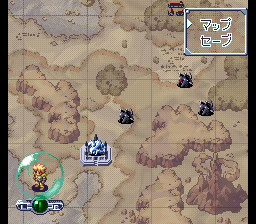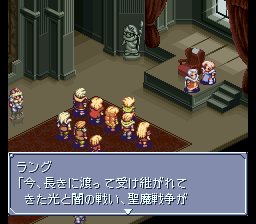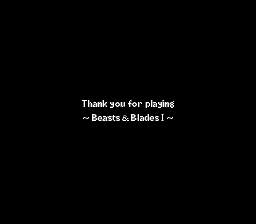Seiju Maden Beasts and Blades (聖獣魔伝ビースト&ブレイド), released 12/15/1995, developed by BPS

This game began as a reader participation game in a magazine. These were very popular in the 80s and 90s although I don’t fully understand how they worked even after reading up on them. You sent in a postcard each “turn” to participate and then somehow things were handled through magazine articles. I know that Play by Mail games were popular here too in the pre-Internet era (I remember them being advertised in Dragon Magazine); maybe they worked in a similar way. I vaguely recall that a previous game I played also began as one of these reader participation games but I can’t find the details.
In any case, the Super Famicom game was based on the franchise; some places say the game came out December 1996 but I think the 1995 date given by other sources is probably correct.
The basic underlying story is that the world is repeatedly fighting battles between the Light and Dark Goddesses. Each time a war starts, one of the races will be chosen to split into two sides and fight for control of the world. The purpose of these wars is unknown; there is a legend that the Goddesses are fighting to become the wife of the supreme God, but why the war would have to be repeated if that is the case is unclear. The reader participation game was planned to have 5 total segments, but it ended after the first 4, so if there was going to be an answer to why the wars were actually being fought, it was never revealed. Both the magazine game and the SFC game start at the beginning of the Fifth War, when humans are the chosen race.

The game is a curious mix of strategy and RPG elements that I think some people would classify as an SRPG — it’s right on the dividing line of my criteria; I think that it may technically qualify as an SRPG under my rules but since I’m playing it either way, it’s not that important. More importantly, I feel like the game is not fully implemented, which I’ll say more about as we go along.
The game begins actually before the war has started. The main character wants to be a “beast master”; the beasts in the title refer to monsters that can be controlled by the characters. You can get beasts from a shop in town, some characters come with beasts, and the Beast Kings get their own special beasts. Over time beasts will become upset and you either have to take them to the shop to fix them (which never worked for me), or use an item that increases their friendliness. (The Beast King special beasts always stay at max friendliness).
This is an area of the game I found confusing. Every character I recruited either came with a beast that could not be changed, or couldn’t control beasts. I never bought a beast from the store or used the services because it never seemed to be allowed — I read the instruction manual but don’t see anything I was doing wrong.

The way you get companions is by using the “friend” command in town until you find someone who can join. You can’t see what type of character they are before you get them on your team which is frustrating. Each character only differs in the type of weapon they use, and whether they can have a beast or not. Weapons can be bought at the shop and also refined into better versions. I believe that each weapon has a fixed maximum it can be levelled when you buy it (maybe randomly chosen?) and if you exceed that it breaks. If you can get a level 4 weapon you can sell it for an enormous sum that will fund all your purchases for the rest of the game. I got one by luck very early in the game so after that I had no money issues.
The game doesn’t really have a strongly developing story. There are a lot of events you can activate — some of them are optional, and some you have multiple choices for which event to do in order to get the next one to open. There’s no real feeling of story progression. Some reviews I saw in Japanese complained that it was difficult to figure out what to do next (I used a walkthrough for this), and I can see that being an issue.

Kurisu accepts a request to go to the west cave to save a little girl. You move on an Ogre Battle like map where you send your guy in real time across the map. The “food” goes down as you move but is very easy to replenish in town. There are random encounters as you go, but most can be easily escaped from.

Battles are done on an SRPG-style grid. Each character starts their turn with a number of points, and each action takes a certain number. You can do as much as you want until you lack the points to do anything else, then that’s the end of your turn.

Inside caves and dungeons, you explore on an isometric style map. The battles in here are fixed (which is why I said that it may technically qualify as an SRPG by my rules).
As Kurisu does the first few events, he meets some of the Dark Kings who recognize that Kurisu is one of the light kings (even though he doesn’t yet) — because the war hasn’t officially started they can’t oppose Kurisu directly, though.
After doing a few of these events, Kurisu eventually learns that he is the First King of Light and heads out to Meishilva Castle to join the other Kings as the war officially starts.

The game now changes once the war starts. You can send out multiple parties at once, each headed by one of the 11 Kings (you don’t have them all at the beginning). In addition, Dark parties will appear on the world map as well and head towards towns or towards the hero parties. The game’s text indicates you should be sending out the parties to protect the towns around the world, and by selecting a town you can see how closely associated the town is with the Dark or the Light. Each town also has a defense rating.

So this seems like it should add some strategy aspects to it, but from what I can tell the system was not actually implemented. From what I saw, any time a dark unit reaches a town the town’s defense always repels it. If heroes are defeated they return to Melshiva castle and the dark unit disappears — this even happens if the hero is already on Melshiva castle. There seems to be no difference between entering a town that is aligned with the Dark or the Light. The only thing that changes is that sometimes when you go to a town you’ll have to join the defense force to fight an attacking unit before you can enter.

So for the most part there is no real purpose in using any unit but the main character, except for one story required event where you have to be using a female unit for it to activate. There are some optional events involving the individual heroes, though.
At this point your goal is simply to go around to places in the world activating various events. As I said earlier there is no feeling of any kind of forward story progression, and the dungeon that basically acts as the “final dungeon” has no feel of finality at all, it just seems like another dungeon. Once you finish that everyone goes back to Melshiva castle, and the castle itself becomes a floating palace to take on the stronghold of the Dark Kings.

This part is annoying because they take away your companions and stick you with two specific Light Kings and give you no opportunity to equip them. Even so this succession of battles was not very hard. If you have the beast masters use the “beast” command they strengthen the beasts who can then use moves that hit all enemies on screen. If you lose these fights for the first time in the game you actually get a game over (in this case I guess an ending where the Dark Goddess wins the war).
At this point the heroes go to a gate where the Light Goddess says it’s time to send the Light Dragon into the world to cleanse it of all the dark people and win the war for Light. If you accept this it apparently leads to another bad ending, so you should refuse. The main God himself then thinks this is interesting and you fight a three headed dragon.

You use all the Kings here but without their beasts. This was kind of a long fight and I lost about half the (unlevelled) Kings but in the end I won. The God decides that the people of the world can now decide their fate for themselves, and that (perhaps) the wars won’t happen again.

I don’t know about this game. It has a lot of interesting components but the actual implementation of them is kind of a mess. If you were playing this just to mess around and send out your people to various towns without worrying about making a lot of progress you might enjoy it, but it’s hard to feel that there’s any kind of story development or whether you’re doing anything productive or not. And as I said earlier, it’s hard to avoid the feeling that the designers had bigger plans for the game that they were not able to implement for whatever reason.